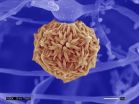(Press-News.org) DURHAM, N.C. – Scientists at Duke University Medical Center have found that larger fungal spores can be more lethal. Their findings about two different spore sizes of the fungus Mucor circinelloides, a pathogen that kills half or more of its victims, could help to develop new treatments and fight other types of fungal infections.
Mucor infection is in the news as an environmental fungus contracted by people who had trauma in the wake of tornadoes in Joplin, Mo. Three out of eight patients had died by June 11. This group of fungi can be common in the environment but only particular hosts with high risks become infected. In Joplin, some people got the fungal infection through traumatic skin wounds.
The study showed a new way to categorize fungi. Scientists traditionally describe a fungus through its growth pattern: either fingerlike hyphal growth, like bread mold, or round and symmetric isotropic growth, like an expanding balloon.
Now the researchers say there is another way to categorize a fungus, by whether it produces larger or smaller spores.
"This kind of dimorphism is something new," said co-senior author Soo Chan Lee, Ph.D. The larger spores can be over than 20 microns, while the tiny spores are only 4-5 microns, the perfect size for penetrating into the recesses of the lungs. The mycologists found that the larger spores caused worse infections in laboratory animals and more readily evaded immune cells.
The work was published in PLoS Pathogens online on June 16.
When the scientists performed an experiment that made the smaller spores grow into larger spores, "We found in that case, the smaller spore that became large acted like the larger spores," Lee said. "We believe that this spore bypassed the natural growth stage of isotropic growth and that was how it becomes more virulent."
"This means we might be able to find a way to arrest them in the smaller stage before they grow into more virulent, larger spores," he said.
Interestingly, other scientists have recently published related findings about the dual cell sizes in another virulent fungal pathogen, Cryptococcus neoformans, in which gigantic cells form in the lungs of infected animals and patients.
Normally immune cells called macrophages engulf and destroy dangerous fungal spores. Small spores can be contained by macrophages, but the larger spores switch too quickly to hyphal growth and thereby can destroy the macrophage. When the macrophages, a first-line defense, split open, they undergo cell death and are unable to protect an infected human or other host animal.
"This finding shows another example of adaptation through fungal cell gigantism, which lets pathogenic fungi establish infection in the hosts, particularly those that are immune compromised," said Joseph Heitman, M.D., Ph.D., co-senior author and chair of the Duke Department of Molecular Genetics and Microbiology. "We used a diabetic model of mice, which is also an immunocompromised type of animal. We found the fungal subspecies that we studied is highly virulent in mice, which correlates well with this subspecies' frequent occurrence in clinical human specimens."
Heitman said the hope is to find a way to arrest the isotropic growth stage. "Clinically, these mucor infections are reasonably common in diabetic patients, transplant patients, and lung-cancer chemotherapy patients," he said. "Having a high blood-glucose level is immunosuppressive, and predisposes diabetic patients to difficult-to-manage fungal infections."
The collaboration for this study grew from pioneering work done by co-authors Rosa M. Ruiz-Vazquez and Santiago R. Torres-Martinez who chose to work at Duke during a sabbatical from the Department of Genetics and Microbiology at the Universidad de Murcia in Murcia, Spain. There they pioneered genetic and genomic approaches to study Mucor. They began by studying the fungus' sensitivity to light, and then took up its pathogenic properties.
The next steps in this research will be to investigate the minus and plus sex determinants of the fungi, which are related to sexual reproduction and spore size, Lee said.
INFORMATION:
Other authors include lead author Charles Li and Deborah Springer of the Duke Department of Molecular Genetics and Microbiology, Maria Cervantes of the Universidad de Murcia, and Teun Boekhout of the CBS-KNAW Fungal Biodiversity Centre in Utrecht, the Netherlands.
Funding came from an undergraduate grant from the Howard Hughes Medical Institute as well as a fellowship from the American Society for Microbiology, the NIH Molecular Mycology and Pathogenesis Training Program, NIH/National Institute of Allergy and Infectious Diseases grants and Spanish Ministerio de Ciencia e Innovación grants.
Size matters -- in virulent fungal spores -- and suggests ways to stop a killer
2011-06-17
ELSE PRESS RELEASES FROM THIS DATE:
AdaptMy.com Has Vision Tips to Reduce Falls in the Home
2011-06-17
Vision impairment is strongly associated with falls. Two of the vision limitations most commonly associated with falls are reduced visual field and impaired contrast sensitivity.
The majority of falls occur in the bathroom. Grab bars can help you regain your balance and prevent these falls, but aren't helpful if visual impairment prevents you from grasping the bars quickly. That is why Andrea Tannenbaum, president of AdaptMy.com, highly recommends bathroom grab bars with a strong contrasting color to the walls.
High contrast colors are much easier to see for people ...
Barrett's esophagus carries lower risk of malignancy than previously reported
2011-06-17
Patients with Barrett's esophagus may have a lower risk of esophageal cancer than previously reported, according to a large, long-term study published online June 16 in the Journal of the National Cancer Institute.
Barrett's esophagus is a premalignant condition, and patients who have it are often advised to have regular endoscopies to watch for signs of esophageal adenocarcinoma, the most common kind of esophageal cancer in many parts of the world. But how often Barrett's esophagus progresses to cancer has not been clear. Previous estimates of the rate of progression ...
Researchers engineer the environment for stem cell development to control differentiation
2011-06-17
Stem cell technologies have been proposed for cell-based diagnostics and regenerative medicine therapies. However, being able to make stem cells efficiently develop into a desired cell type -- such as muscle, skin, blood vessels, bone or neurons -- limits the clinical potential of these technologies.
New research presented on June 16, 2011 at the annual meeting of the International Society for Stem Cell Research (ISSCR) shows that systematically controlling the local and global environments during stem cell development helps to effectively direct the process of differentiation. ...
Plants teach humans a thing or two about fighting diseases
2011-06-17
Avoiding germs to prevent sickness is commonplace for people. Wash hands often. Sneeze into your elbow. Those are among the tips humans learn.
But plants, which are also vulnerable to pathogens, have to fend it alone. They grow where planted, in an environment teeming with microbes and other substances ready to attack, scientists note.
Now, researchers are learning from plants' immune response new information that could help them understand more about humans' ability to ward off sickness and avoid autoimmune diseases.
This week's journal Science reports findings by ...
A stem cell target for expanding waistlines?
2011-06-17
Researchers may have found the key to developing a method to rid the body of stem cells responsible for driving fat expansion. According to a report in the June 16 Cell Stem Cell, a Cell Press publication, they've landed the first protein marker on the surface of those so-called adipose stromal cells (ASCs), which serve as progenitors of the cells that make up fat tissue.
"Our long-term goal is to identify an approach to inactivate these cells in disease," said Mikhail Kolonin of University of Texas Health Science Center at Houston. "By administering a peptide with a ...
How we come to know our bodies as our own
2011-06-17
By taking advantage of a "body swap" illusion, researchers have captured the brain regions involved in one of the most fundamental aspects of self-awareness: how we recognize our bodies as our own, distinct from others and from the outside world. That self-perception is traced to specialized multisensory neurons in various parts of the brain that integrate different sensory inputs across all body parts into a unified view of the body.
The findings, reported online on June 16 in Current Biology, a Cell Press publication, may have important medical and industrial applications, ...
FrontDoorSoftware Laptop Tracking and Security Startup Nominated for the 11th Annual Apex Awards for Technology Company of the Year
2011-06-17
FrontDoorSoftware Corporation has been nominated for a 2011 Apex Award in the category of Technology Company of the Year. The Apex Awards are awarded annually to the top technology companies by the Colorado Software and Internet Association (CSIA), or "Colorado's Technology Association."
"We are thrilled to be nominated for the Apex Awards' Technology Company of the Year," said Carrie Hafeman, president of FrontDoorSoftware Corporation. "The CSIA and its members represent outstanding achievements and progress in software, technology, and the ...
Counting the cost of cold winters: Emergency treatment for falls on snow and ice
2011-06-17
During the winter of 2009-2010 the average temperature for the UK was 1.6 degrees centigrade (°C), making it the coldest recorded winter in the last 30 years. Using winter data from 2005 to 2010, new research published in BioMed Central's open access journal Environmental Health demonstrates an inverse relationship between temperature and the number of falls on snow and ice, which result in emergency admission to hospital, and looks at the cost of these falls.
Researchers from the North West Public Health Observatory, based at the Centre of Public Health, Liverpool John ...
After 55 years, surgery restores sight
2011-06-17
After being hit in the eye by a stone, a detached retina left a man blind in his right eye. Despite surgery to remove a cataract when the man was 23, which temporarily restored light perception, the patient was completely blind in that eye. Doctors at The New York Eye and Ear Infirmary have reported a case, published in BioMed Central's open access Journal of Medical Case Reports, describing how this patient had functional vision restored 55 years after the childhood accident which left him blind.
Whilst it is unusual for a retina to become detached, common causes include ...
Sharing anonymized hospital data prevents violence
2011-06-17
Combining information from hospitals and police can prevent violence and make communities safer, according to a study published on bmj.com today.
The World Health Organisation (WHO) has identified interpersonal violence as a global public health issue. In 2008-9, police recorded over 900,000 violent incidents in England and Wales, yet a substantial proportion of violence which results in treatment by doctors is not known to the police.
Targeted police work prevents violence, but depends on knowledge of when and precisely where violence occurs. So a team led by Professor ...


